- Jun 11, 2022
- 23
- Pool Size
- 20440
- Surface
- Plaster
- Chlorine
- Salt Water Generator
- SWG Type
- CircuPool Universal40
Situation
Near Austin, TX. 20k gallon above ground plaster pool, built 2021. ~15' infinite edge, spill over hot tub. Builder refused to go salt during the build (very few pools in this area are salt). The builder said, just add these pucks, don't do anything else. I instead added ~40 ppm of cyanuric stabilizer in Sept 2021, then used 3" pucks via a chlorinator, per the pool builder after that. Texas heat is serious business. By April, 55 CYA, by June 85 CYA (record heat and ~ 20' of water edges in total). Algae appeared on the walls about once very ~ 10 days but a pool brushing solved it. Switched to bleach to keep the CYA in check and quickly got tired of lugging jugs.
All of my pool equipment is essentially below the pool, incased in a gunite room.
I'm sharing my real-world process. I had some challenges but I would 100% do it again (I'll update if this changes). Please read through to the end if your concerned about the conversion process. Without my hiccup, it would have taken ~1 hour at most.
Side note: in this time alone: when I finally tested the water for salt ppm to switch over it was already 800 ppm (Taylor salt kit).
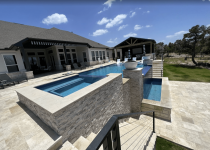
Buying
Post for buying input: RJ-60 vs PL7703 July 28, 2022. I bought the PL7703 from Inyo Pools July 2nd for $1,089.99. July 5th they cancelled the order due to stock issues. This would have been a 60k gallon unit for a 20k pool, a great value at this price. I was bummed but Inyo was not able to provide a restock date. As of this post, they are still out of stock.
@needsajet created an amazing SWCG cost calculator. I modified it a little to input the latest prices for the units under consideration (my costs include shipping, tax, etc). In short, this helped me determine that a 40k gallon rating was reasonable for me. In short, I'm good with a 4 year (ish) warranty and if the cell lasts 5+ years I'll be more than happy. In a perfect scenario, the "10,000 hour" cell house lasts > 10 years but I'm not depending on that. My break-even is roughly 1 year and some change in my location (free labor and $6 gallon chlorine, > 100f heat daily gets there fast).
I ultimately purchased the CircuPool Universal40 (U40) for $1,074. This is basically the same unit as the PL7703 but rated for 20k gallons less at the same price (less value but available to buy). I liked the see-through panel, the potential to replace the cell in the future with other brands, the potential to integrate with my automation (with an adapter .. still working on this), the ability to adjust in 1% increments, a good cost vs warranty and a reputable brand. I did not like that CircuPool makes this model non-transparent but I overcame this with my existing transparent backflow units, which show bubbles if the unit is running (to the spa [overflow]).
Side note: I bought the unit from Discount Salt Pools and the flow sensor wasn't working. I purchased a new flow sensor from Amazon in parallel just in case and I'm glad I did. I followed up yesterday and as of this post it's been 7 days with NO response from this vendor.
(But the manufacturer, CircuPool has been quick to respond).
The install
I asked the pool builder to install it. This would have meant full warranty and a time savings, they refused. "We don't know how to install salt water equipment". No problem, I'm reasonably handy....
The electrical and mounting was easy. I wired it in with the main pump so if it turned on, the U40 turned on.
I bonded the Circupool unit and while I was at it notices 2 of the pumps and the heater were not bonded, fixed.
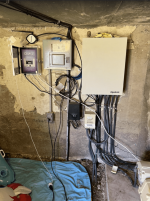
(This view/roomis to the left and under spa, under the deck)
The U40 itself was also a quick job, a few cuts and good to go. Note: the manual is wrong on the length, by about 3". Measure it yourself before making the cuts. But this came after the hard part ...
The hard part
With a spa overflow, I wanted the chlorine generating in pool mode but not if the spa was is in use. This would solve one of our complaints where the chlorine rises dramatically with 2-3 hours in the spa. This turned out to be my hardest challenge.
I tried to very precisely cut here (see pic), and after cleaning, priming and gluing ... leak. Tore it apart, repeated and leak. There was very little flex in these pipes, even after digging (they go straight under the concrete slab). If your in this situation, just bite the bullet and youtube how to remove PVC or hire a plumber).
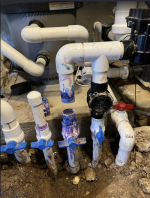
To my pool builder's credit, I 911'd my screw up at 10pm and the plumber arrived the next day. They removed the 90, chiseled out the connecting pipe and installed a flow sensor style pipe the very next day. But they still refused to install the actual U40 while here.
Unfortunately for me, this heavy-duty T pipe added a good 1/2" in extra length vs the original and the flow sensor was not happy. I had to surge > 3,000 RPM to trip the sensor off, and then, after even 2,000 RPM for 4 hours, it would eventually trip on again. Prior to this I could run the main flow pump at 1,345 RPM and achieve overflow and nice circulation. The flow sensor not tripping was in part because some of my water flow goes to the spa overflow, in part because I'm not meeting the recommended 12" straight pipe for the flow sensor (?), and I think because the plumbers installed heavy duty T, which pushed the sensor out further than it was supposed to be. I tried for three pain-staking days to find a reasonable flow vs power setting to keep the unit on but ultimately gave up on this.
Solution: I knew the overfall (overflow + pool) flow was good to go based on the RPM and the manual for this pump, with plenty of buffer). So, I extended the flow sensor with some extra plastic and glue. It doesn't trip until > 1100 RPM's which should be above the GPM requirements for the unit. Not perfect but between this and the unit shutting off if the pump is off, I'm comfortable enough.
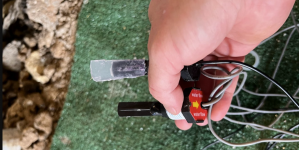
Side note (learning)
I originally thought it would be cool to keep the chlorinator here but what I didn't expect is that the gas from the UL40 somehow escaped the chlorinator (empty and with full flow set). As as result, I smelled chlorine when entering the enclosed room. This could be because of a faulty chlorinator unit (replaced ~5 months ago but for some reason is often without water) or other .. but regardless, I capped it off (see pics) and no more smell.
Final install
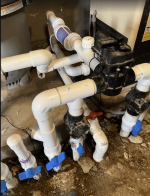
A 61% setting (still tuning) at 14 hours per day seems to do the trick to hold 6 ppm of chlorine in July here. The family loves the softness of the pool water, less chlorine, and I love the significantly decreased maintenance. I feel great about going on vacation now and not worrying about the pool, a nice change.
I hope this helped someone out there.
Please don't let this persuade you not to convert. This would have been a ~1 hour job, if not for the overflow and sensor problem. We (whole family) are super happy about the conversion!
Near Austin, TX. 20k gallon above ground plaster pool, built 2021. ~15' infinite edge, spill over hot tub. Builder refused to go salt during the build (very few pools in this area are salt). The builder said, just add these pucks, don't do anything else. I instead added ~40 ppm of cyanuric stabilizer in Sept 2021, then used 3" pucks via a chlorinator, per the pool builder after that. Texas heat is serious business. By April, 55 CYA, by June 85 CYA (record heat and ~ 20' of water edges in total). Algae appeared on the walls about once very ~ 10 days but a pool brushing solved it. Switched to bleach to keep the CYA in check and quickly got tired of lugging jugs.
All of my pool equipment is essentially below the pool, incased in a gunite room.
I'm sharing my real-world process. I had some challenges but I would 100% do it again (I'll update if this changes). Please read through to the end if your concerned about the conversion process. Without my hiccup, it would have taken ~1 hour at most.
Side note: in this time alone: when I finally tested the water for salt ppm to switch over it was already 800 ppm (Taylor salt kit).

Buying
Post for buying input: RJ-60 vs PL7703 July 28, 2022. I bought the PL7703 from Inyo Pools July 2nd for $1,089.99. July 5th they cancelled the order due to stock issues. This would have been a 60k gallon unit for a 20k pool, a great value at this price. I was bummed but Inyo was not able to provide a restock date. As of this post, they are still out of stock.
@needsajet created an amazing SWCG cost calculator. I modified it a little to input the latest prices for the units under consideration (my costs include shipping, tax, etc). In short, this helped me determine that a 40k gallon rating was reasonable for me. In short, I'm good with a 4 year (ish) warranty and if the cell lasts 5+ years I'll be more than happy. In a perfect scenario, the "10,000 hour" cell house lasts > 10 years but I'm not depending on that. My break-even is roughly 1 year and some change in my location (free labor and $6 gallon chlorine, > 100f heat daily gets there fast).
I ultimately purchased the CircuPool Universal40 (U40) for $1,074. This is basically the same unit as the PL7703 but rated for 20k gallons less at the same price (less value but available to buy). I liked the see-through panel, the potential to replace the cell in the future with other brands, the potential to integrate with my automation (with an adapter .. still working on this), the ability to adjust in 1% increments, a good cost vs warranty and a reputable brand. I did not like that CircuPool makes this model non-transparent but I overcame this with my existing transparent backflow units, which show bubbles if the unit is running (to the spa [overflow]).
Side note: I bought the unit from Discount Salt Pools and the flow sensor wasn't working. I purchased a new flow sensor from Amazon in parallel just in case and I'm glad I did. I followed up yesterday and as of this post it's been 7 days with NO response from this vendor.
(But the manufacturer, CircuPool has been quick to respond).
The install
I asked the pool builder to install it. This would have meant full warranty and a time savings, they refused. "We don't know how to install salt water equipment". No problem, I'm reasonably handy....
The electrical and mounting was easy. I wired it in with the main pump so if it turned on, the U40 turned on.
I bonded the Circupool unit and while I was at it notices 2 of the pumps and the heater were not bonded, fixed.

(This view/roomis to the left and under spa, under the deck)
The U40 itself was also a quick job, a few cuts and good to go. Note: the manual is wrong on the length, by about 3". Measure it yourself before making the cuts. But this came after the hard part ...
The hard part
With a spa overflow, I wanted the chlorine generating in pool mode but not if the spa was is in use. This would solve one of our complaints where the chlorine rises dramatically with 2-3 hours in the spa. This turned out to be my hardest challenge.
I tried to very precisely cut here (see pic), and after cleaning, priming and gluing ... leak. Tore it apart, repeated and leak. There was very little flex in these pipes, even after digging (they go straight under the concrete slab). If your in this situation, just bite the bullet and youtube how to remove PVC or hire a plumber).

To my pool builder's credit, I 911'd my screw up at 10pm and the plumber arrived the next day. They removed the 90, chiseled out the connecting pipe and installed a flow sensor style pipe the very next day. But they still refused to install the actual U40 while here.
Unfortunately for me, this heavy-duty T pipe added a good 1/2" in extra length vs the original and the flow sensor was not happy. I had to surge > 3,000 RPM to trip the sensor off, and then, after even 2,000 RPM for 4 hours, it would eventually trip on again. Prior to this I could run the main flow pump at 1,345 RPM and achieve overflow and nice circulation. The flow sensor not tripping was in part because some of my water flow goes to the spa overflow, in part because I'm not meeting the recommended 12" straight pipe for the flow sensor (?), and I think because the plumbers installed heavy duty T, which pushed the sensor out further than it was supposed to be. I tried for three pain-staking days to find a reasonable flow vs power setting to keep the unit on but ultimately gave up on this.
Solution: I knew the overfall (overflow + pool) flow was good to go based on the RPM and the manual for this pump, with plenty of buffer). So, I extended the flow sensor with some extra plastic and glue. It doesn't trip until > 1100 RPM's which should be above the GPM requirements for the unit. Not perfect but between this and the unit shutting off if the pump is off, I'm comfortable enough.

Side note (learning)
I originally thought it would be cool to keep the chlorinator here but what I didn't expect is that the gas from the UL40 somehow escaped the chlorinator (empty and with full flow set). As as result, I smelled chlorine when entering the enclosed room. This could be because of a faulty chlorinator unit (replaced ~5 months ago but for some reason is often without water) or other .. but regardless, I capped it off (see pics) and no more smell.
Final install

A 61% setting (still tuning) at 14 hours per day seems to do the trick to hold 6 ppm of chlorine in July here. The family loves the softness of the pool water, less chlorine, and I love the significantly decreased maintenance. I feel great about going on vacation now and not worrying about the pool, a nice change.
I hope this helped someone out there.
Please don't let this persuade you not to convert. This would have been a ~1 hour job, if not for the overflow and sensor problem. We (whole family) are super happy about the conversion!
Last edited:

